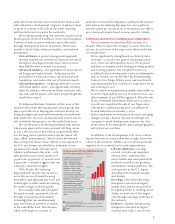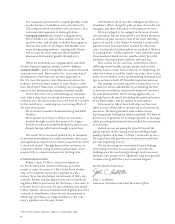Eli Lilly 2009 Annual Report Download - page 15
Download and view the complete annual report
Please find page 15 of the 2009 Eli Lilly annual report below. You can navigate through the pages in the report by either clicking on the pages listed below, or by using the keyword search tool below to find specific information within the annual report.
•Effient»,for the reduction of thrombotic cardiovascular events (including stent thrombosis) in patients
with acute coronary syndrome who are managed with an artery-opening procedure known as
percutaneous coronary intervention (“PCI”), including patients undergoing angioplasty, atherectomy,
or stent placement
•ReoPro»,for use as an adjunct to PCI
•Xigris»,for the treatment of adults with severe sepsis at high risk of death
Animal health products, including:
•Rumensin»,a cattle feed additive that improves feed efficiency and growth and also controls and
prevents coccidiosis
•Tylan»,an antibiotic used to control certain diseases in cattle, swine, and poultry
•Micotil»,Pulmotil»,and Pulmotil AC»,antibiotics used to treat respiratory disease in cattle, swine, and
poultry, respectively
•Paylean»and Optaflexx»,leanness and performance enhancers for swine and cattle, respectively
•Posilac», a protein supplement to improve milk productivity in dairy cows. We acquired the worldwide
rights to Posilac from Monsanto Company in August 2008.
•Coban», Monteban»,and Maxiban», anticoccidial agents for use in poultry
•Apralan», an antibiotic used to control enteric infections in calves and swine
•Surmax»(sold as Maxus»in some countries), a performance enhancer for swine and poultry
•Elector», a parasiticide for use on cattle and premises
• Two products for dogs: Comfortis», the first FDA-approved, chewable tablet that kills fleas and
prevents flea infestations on dogs; and Reconcile», for treatment of canine separation anxiety in
conjunction with behavior modification training
Other pharmaceuticals, including:
•Vancocin»HCl, used primarily to treat staphylococcal infections
•Ceclor
TM
,for the treatment of a wide range of bacterial infections.
Marketing
We sell most of our products worldwide. We adapt our marketing methods and product emphasis in
various countries to meet local needs.
Pharmaceuticals—United States
In the United States, we distribute pharmaceutical products principally through independent wholesale
distributors, with some sales directly to pharmacies. Our marketing policy is designed to assure that
products and relevant medical information are immediately available to physicians, pharmacies, hospitals,
public and private payers, and appropriate health care professionals. Three wholesale distributors in the
United States—AmerisourceBergen Corporation, McKesson Corporation, and Cardinal Health, Inc.—each
accounted for between 12 percent and 17 percent of our worldwide consolidated net sales in 2009. No
other distributor accounted for more than 10 percent of consolidated net sales. We also sell pharmaceu-
tical products directly to the United States government and other manufacturers, but those sales are not
material.
We promote our major pharmaceutical products in the United States through sales representatives who
call upon physicians and other health care professionals. We advertise in medical journals, distribute
literature and samples of certain products to physicians, and exhibit at medical meetings. In addition, we
advertise certain products directly to consumers in the United States and we maintain web sites with
information about all our major products. Divisions of our sales force are assigned to therapeutic areas,
such as neuroscience, diabetes, osteoporosis, and oncology. We supplement our employee sales force with
contract sales organizations as appropriate to leverage our own resources and the strengths of our
partners in various markets.
Large purchasers of pharmaceuticals, such as managed-care groups, government agencies, and long-
term care institutions, account for a significant portion of total pharmaceutical purchases in the United
States. We maintain special business groups to service wholesalers, managed-care organizations, govern-
ment and long-term care institutions, hospitals, and certain retail pharmacies. In response to competitive
pressures, we have entered into arrangements with these organizations which provide for discounts or
rebates on one or more Lilly products.
Pharmaceuticals—Outside the United States
Outside the United States, we promote our pharmaceutical products primarily through sales representa-
tives. While the products marketed vary from country to country, neuroscience products constitute the
largest single group in total sales. Distribution patterns vary from country to country. In most countries,
3
FORM 10-K
























